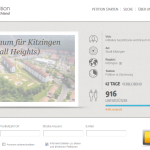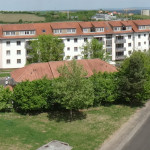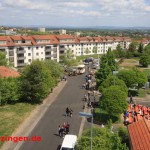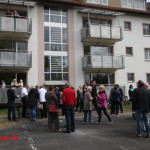
The current status of the Marshall Heights housing area
A report in english language on the current status of the former US-military housing area “Marshall Heights”, Kitzingen, Frankonia.
As a small local online news site, we were pretty stumbled about the demand on information about Marshall Heights from Locations in the USA. As we published a small article, showing some pictures taken with a quadcopter, the number of page visitors simply killed our servers for over an hour. We strengthened our servers now – and react with this special article for mostly english speaking visitors of our first article.
We won’t go into every detail, but this article is thought to provide a general overview with some background for those, who didn’t follow all the developments after the US-Military moved away.
The day after the military presence
After the Troops had gone, all the barracks, the circles and even the housing areas were handed over to the German federal state. The federal bureau for real estate related tasks – in German language “Bundesanstalt für Immobilienaufgaben” shortened with BIMA – got the duty to care about all Kitzingen’s former military real estate property.
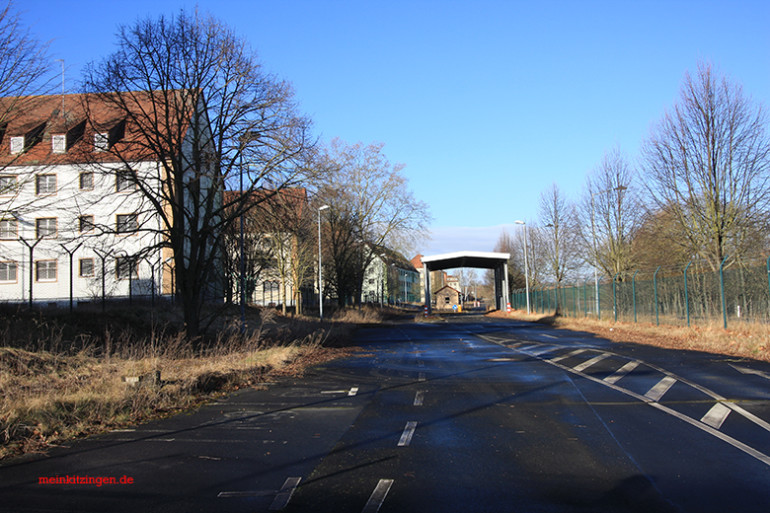
The German military, the ‘Bundeswehr’, did not want to operate or take over this military infrastructure. It was confronted with several reforms in the last decade. As well, the Bundeswehr finally stopped dragging people into the draft service and started to focus on highly trained and professional troops in smaller numbers. These reforms did not increase the need for more military bases instead they leaded into a reduction of armed troops and even closures of Bundeswehr owned military sites.
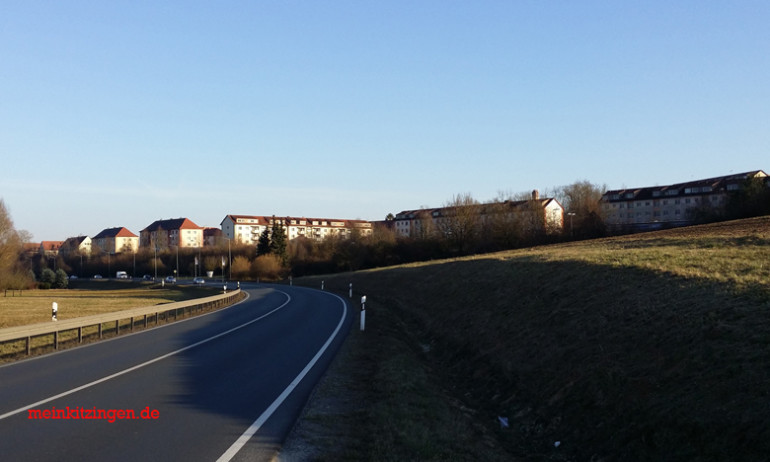
Other public governmental organizations did not show any interest on using the free places for their purposes. The BIMA finally decided to sell all the real estate properties in Kitzingen into private hands.
Things have already changed with the military sites
The BIMA already finished selling the Corlette Circle, a former housing area near the Harvey Barracks. It will be used soon to shelter asylum seekers.
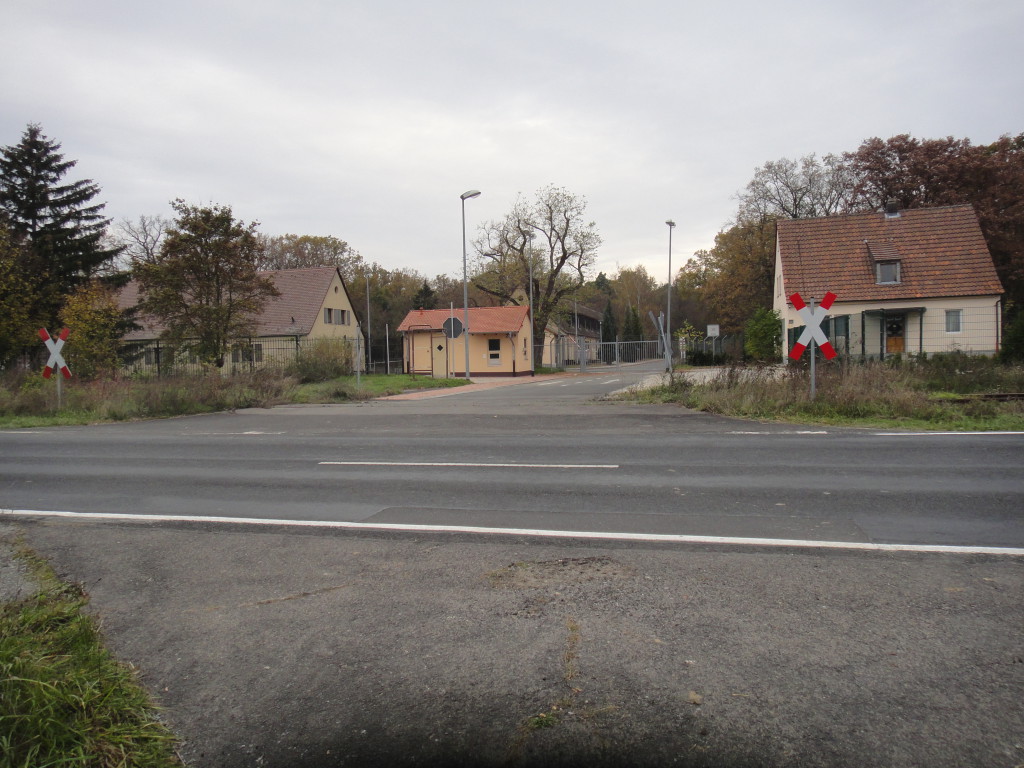
The Richthofen Circle, which is beneath the Corlette Circle has become a luxury resort for horse sports after it was sold.
The airport in the former Harvey Barracks is closed on one half of the formerly very long strip. The space is used for a photovoltaic power plant, generating electricity by using the power of the sun. The other half of the strip is still used for aviation, but only for aviation related to sport or leisure. Planes only take off when certain weather conditions are met. All lightning of the strip or other systems for flying in bad weather conditions and at night have been dismounted. The rest of the Harvey Barracks are going to be developed by a private company. The Harvey Barracks were renamed; they are now called “ConneKT”, a game of words referring to connecting businesses and industry with the abbreviation for Kitzingen ‘KT’.
The Larson Barracks have developed in a similar way. They were renamed into “Innopark”, which is a statement to be an industrial area for very innovative companies. However, a lot of green tech businesses and smaller startups are operating here. As well, the State Archive of Bavaria with 7000 square meters full of historic documents will move into the Innopark by 2018.
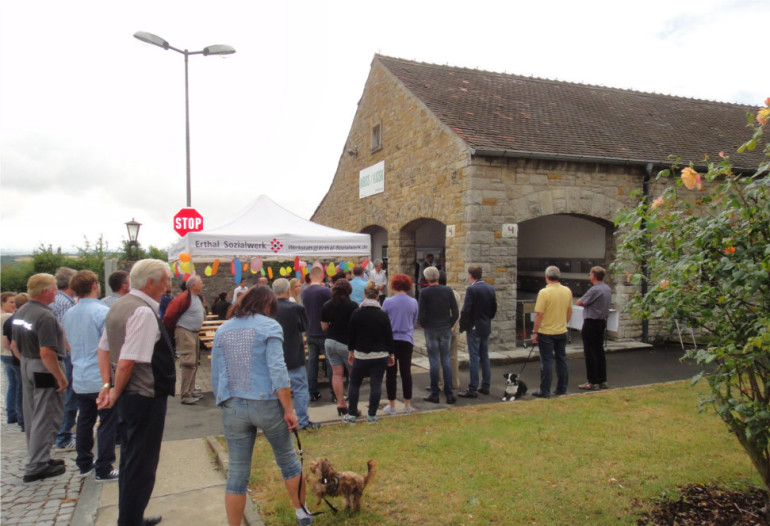
The only thing, that was not sold by BIMA until last month was the housing area Marshall Heights.
The golden years of Kitzingen and their consequences in the real estate market
To understand the general dispute over the development of the Marshall Heights, taking a look into the real estate market is necessary.
The moment, the troops left Kitzingen, it was for many Kitzinger’s not easy to continue making a living like before. While troops had their bases in Kitzingen, citizens of Kitzingen just needed to open a bar, a gambling site or other simple services, which young male man with enough money to spend and a certain level of boredom like. Just to name them: sex, alcohol, music, food, joy. And people from university are not needed to do these tasks.
Good times are over now – but most of the citizens haven’t changed. Not in person and most of them haven’t even changed their mindset.
In the moment, some thousand young soldiers stopped spending their money in Kitzingen, obvious things should happen in a normal economy: prizes for most services should drop, a lot of these services should close, because they cannot adapt to the new situation and find new or enough clients. These expected effects should even go as far as renting a home is becoming much cheaper, after some have moved away.
In Kitzingen, this hasn’t happened at all. Most bars and restaurants are still open; a nearly empty gambling hall is still waiting 24 hours for fools to lose their money. As if the soldiers haven’t gone yet at all. This upkeep of operation continues to work, because since the soldiers have gone, only little invest was made. Nearly nothing was invested in restaurants. Some of the taxis still in operation in Kitzingen were put in service in the mid-90’s. This continues in real estate – at least some parts of the inner city of Kitzingen were modernized with subsidies, as the tourist sector was frightened from how desolate Kitzingen presents itself to it’s guests.
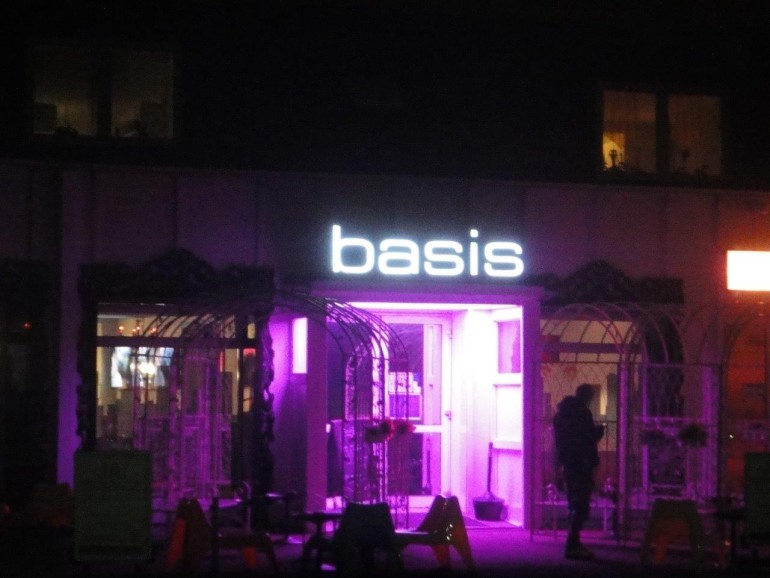
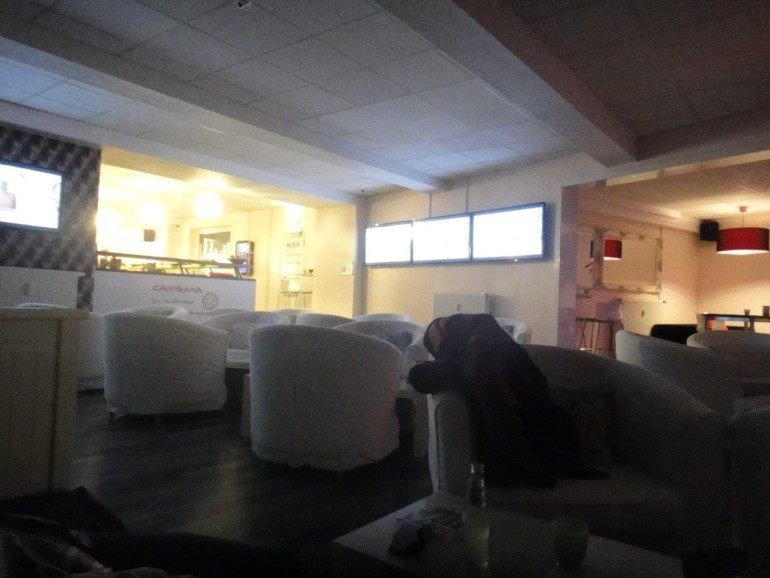
The mechanism behind this is simple: If you can’t find someone to rent your flat in Kitzingen, you won’t invest a penny in your flat. This decision by many Kitzinger is based on their inability to change their mindset. If they would rethink, they either would go down with the prizes or invest into the flat to offer an appropriate level. In the last 50 years, they always could find someone to rent it – even for 10% more. To be clear: I am not blaming them for acting this way with their property, this situation – soldiers moving out of Kitzingen after nearly 50 years – must feel like the end of communism for eastern European people. All this uncertainty, these new demands and if you see it in a local manner: a new motor for businesses has replaced the army and you need to adapt to it.
In Innopark and ConneKT jobs are created mostly for high educated and specialized employees, but the persons to fill these jobs are mostly found far outside Kitzingen, like Munich or Frankfurt. Kitzingen with its US-soldiers was like a goldmine for lower qualified German workers – servants, drivers and so on. And green tech needs engeneers, not former servants from a restaurant which has reduced staff but continues operation.
High educated and specialized employees, who want to move to Kitzingen, often find their expectations on renting a flat or a house met with a horror of inappropriate prizes or nearly rotten rooms. Arguing about either the prize or the conditions is just leading into a waste of time – most of the real estate owners have still full pockets from Kitzingen’s long lasting golden years and don’t need to find someone to rent it at any cost. And this closes the cycle: no one found, no invest, no change.
For these new citizens of Kitzingen, the situation becomes often unbearable and Kitzingen’s companies really struggle hard to keep their employees, they once attracted to Kitzingen, in their positions and from going away again. Kitzingen had until now a very successful start into the post-military era, but this huge project – called “Konversion” in german language – might get stuck in the irrational real estate situation in Kitzingen.
Apart from these local effects in Kitzingen, there are some supporting effects from German economy: Very low interest rates for money put at the bank and even lower interest rates for financing real estate property effected a general rise of the value of real estate property.
The war about Marshall Heights and City Development
The city parliament – “Stadtrat” in German language – and the major of Kitzingen really messed up the situation with the Marshall Heights with their decisions and actions. But let’s start this story from begin:
From the passage before, we know, Kitzinger real estate owners have not really realized right now, that in fact all the soldiers have gone. They just can’t find new people to rent their properties. And that’s why they don’t invest into their property and demand the same price as before – but for rotten or at least inappropriate rooms.
In a polling, the majority of Kitzinger citizens ordered the City of Kitzingen, not to use the right of preemption on the 720 flats in Marshall Heights. This result was often commented as fear from competition in the real estate market in Kitzingen. Officially the campaigners for a “no” admitted to be afraid of an empty ruin, because nobody would need these homes in their opinions.
As a result of this polling, the BIMA offered the Marshall Heights in a bidding to anyone willing to buy.
Before the bidding was over, the city parliament, decided how to use the Marshall Heights, even if they were not sold to the City. They wanted to clear the complete rear part for nature – over the half of the Marshall Heights. Some blocks in the front of Marshall Heights should remain and some other parts, the former school and the bowling hall was planned to become another commercial zone. The former youth center AYA was the only part, the city wanted to bid for.
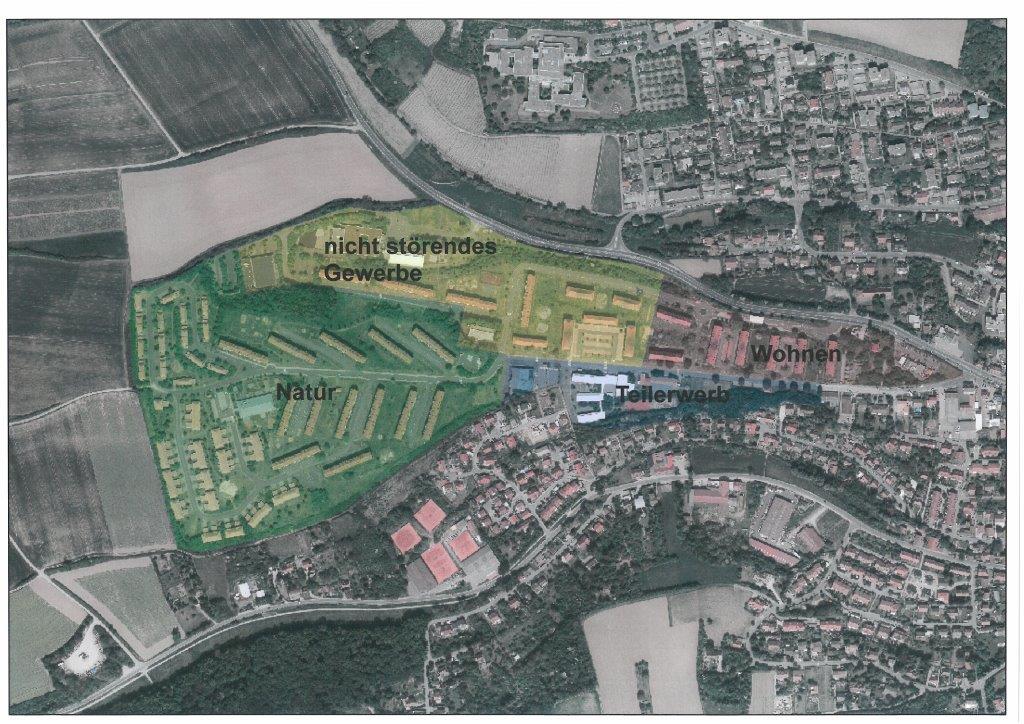
But the BIMA did not set up the bidding in order to sell parts of the Marshall Heights; it wanted to sell it completely in one peace and as soon as possible. But the Stadtrat, filled with people, whose minds are still stuck in the golden times of Kitzingen, did not consider the interests of the BIMA in their decision. Instead, the Stadtrat often considers itself as the middle of earth while making its descissions. So they voted in November 2013 for this plan and for bidding on a very small part of the Marshall Heights. As a result, the bid of the city Kitzingen was later simply refused by BIMA.
In November 2013, they also voted a position on reading the German law of construction: Their position was, that any new owner had no right realizing and using the Marshall Heights without involving the City of Kitzingen’s plans from November 2013. This would mean only few homes and tearing down over the half. They argued this position with their special reading and interpretation of German law for construction. In Germany, constructions on buildings must be approved before construction and the laws are tough. But the Marshall Heights was US-military housing, so it didn’t need any approving procedure by German law, when it was build.
As well, the German law knows grandfathering (the right to continue a usage of a building after a porperty is sold) – for existing buildings and as long you don’t change the use of them. The city parliament denied the possibility of any grandfathering for Marshall Heights with their reading. Their thesis behind their reading is, Marshall Heights was a former militairy object. But it would need to be a normal housing area to continue the usage as housing area. It was a very clear more or less political promise they gave to any interested bidder: “You might buy Marshall Heights, but we will be approving, weather and how you will use it.”
The BIMA always positioned for grandfathering, which might have served the interest of selling Marshall Heights quickly. BIMA rejected the thesis, Marshall Heights to be a militairy site. In their opinion Marshall Heights was a specialized housing area – but it was a housing area.
In fact, the law is, even since it fills complete books, not helpful finding out if there is a grandfathering on Marshall Heights and if a new owner could use all the homes in Marshall Heights or if these buildings need their approval first (if they ever get it). So answering this question – basicly a question on the categorization of the former use – was expected anyways to happen at court.
Now a month ago, the decision who is the winner in the bidding, has been announced by BIMA. Georg Wittmann, a citizen of Kitzingen and professional real estate developer won. The coup was, that he bought another former housing area by BIMA before. He owns the Corlette Circle. When he was asking the City of Kitzingen to approve this former housing area into a shelter for asylum seekers, the city of Kitzingen replied this wouldn’t need an approval as this usage is covered by grandfathering: Sheltering asylum seekers is housing like sheltering soldiers was.
Last week Georg Wittmann presented his plans on developing Marshall Heights. He used this possibility to argue about the grandfathering issue in Marshall Heights – his opinion: It’s not lawful, if in one case, like former Corlette Circle, grandfathering applies and in the case of Marshall Heights, grandfathering is denied. This behavior of the city parliament is not appropriate for a constitutional democracy. Also the City of Kitzingen used the school in the Marshall Heights as temporary replacement building while a school in downtown was modernized. Wittmann concluded, that even the City of Kitzingen itself was acting as if grandfathering was given in Marshall Heights, otherwise it would not have been allowed to use the school in Marschall Heights temporarly.
The major of Kitzingen rejected this opinions as expectable. If major, city parliament and Georg Wittmann won’t find a solution on this question, a court will. But meanwhile, the Marshall Heights will keep on being unused – like the last 9 years. Even though, the real estate market is irrational in Kitzingen and the Konversion might get stuck as new employees for the new companies in Kitzingen can’t find appropriate housing, less members of the Stadtrat acknowledge the need to get a development done quickly.
In reaction of this, a former Kitzinger citizen initiated an online-petition to fight for housing in the marshall heights. It can be signed by anyone, but only votes from kitzingen are counted.
Great new plans for Marshall Heights
Georg Wittmann presented his plans of developing the Marshall Heights to the public:
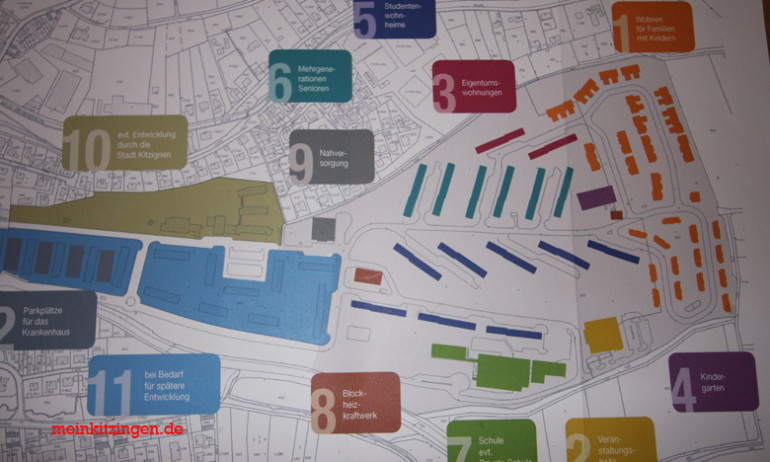
He wanted refurbish 8 blocks as homes for students (deep blue colored in the image). The Marshall Heights are very close to the new university in Würzburg, which is also using a former US-military base.
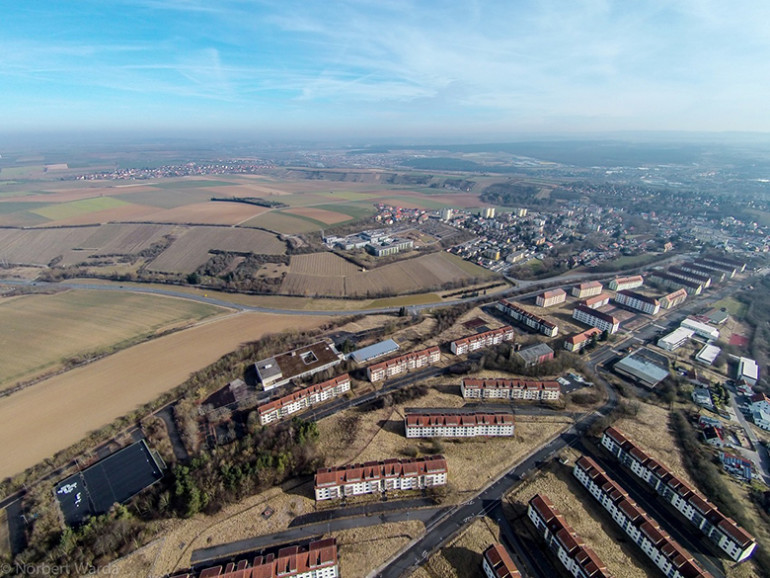
6 Blocks should be modernized for a multi-generation-living project (cyan colored in the image). This is a special form of housing, where an environment of normal society is created around elder people. This keeps elder people from feeling lonely or depressed and gives them interaction with society. This concept has proofed elder people to remain longer active and finding new positive tasks.
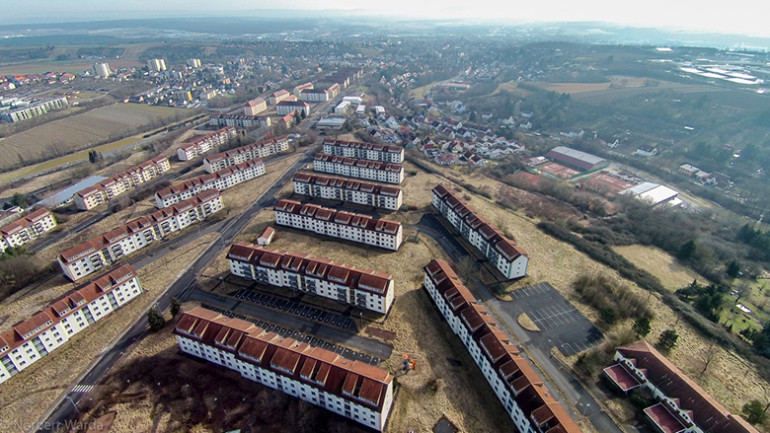
Wittmann wants the wooden family houses to be used by families again (orange colored in the image). As well, two blocks should be specially refurbished as living place for young families (dark red colored in the image).
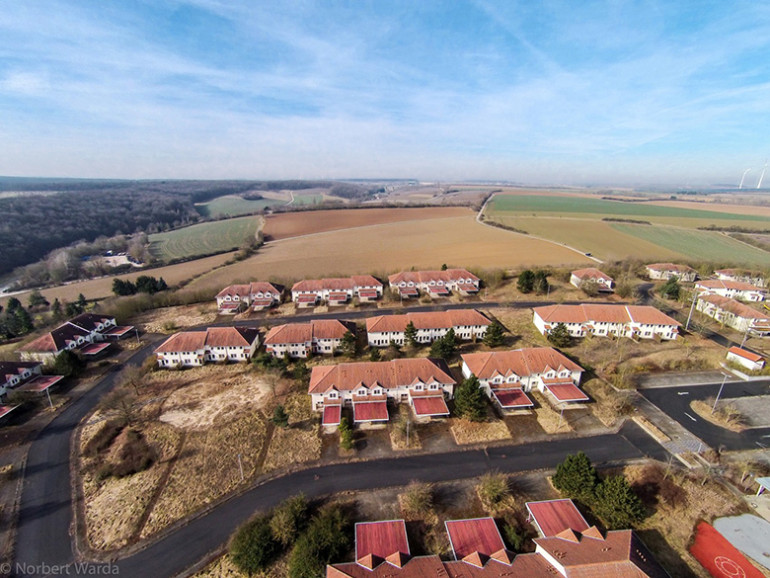
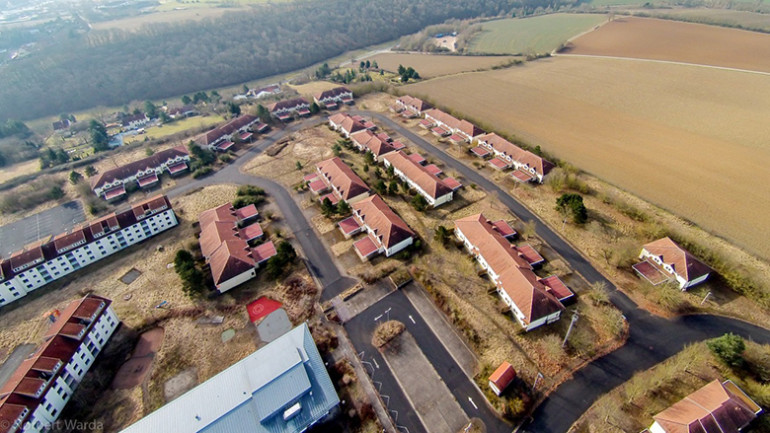
If families move into Marshall Heights, a Kindergarden is required (pink colored). Wittmann planned it in the middle of the housing area, so it is easy to access for all families.
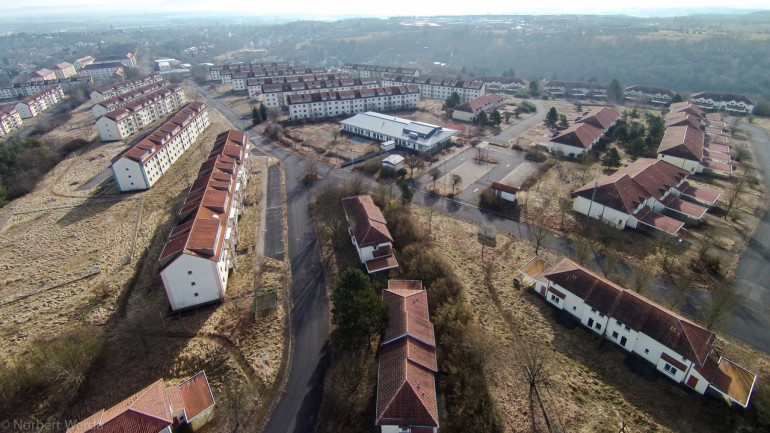
The former bowling hall could become Kitzingen’s new city hall (yellow colored) and a private school could use the existing school buildings (green colored). Wittmann wants to develop a complete new part of the city – anyway a huge project for itself but just one part of the Konversion.
If you like this content, feel free to share it or to donate. Thank you for reading.

